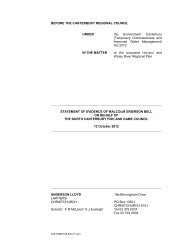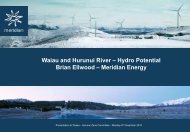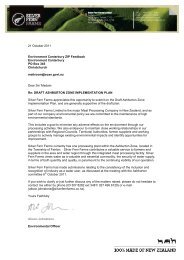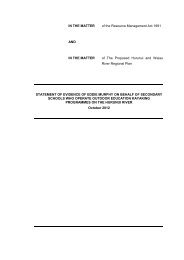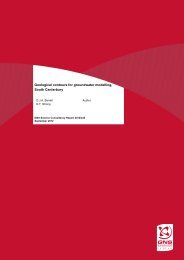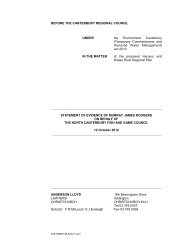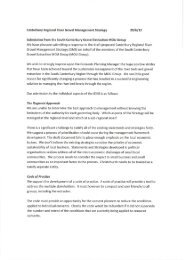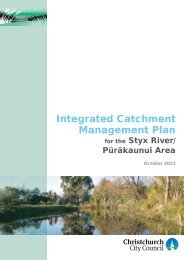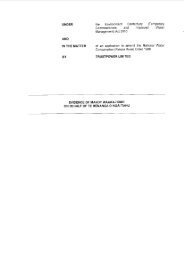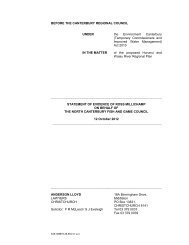Evidence of Martin Unwin - Environment Canterbury
Evidence of Martin Unwin - Environment Canterbury
Evidence of Martin Unwin - Environment Canterbury
Create successful ePaper yourself
Turn your PDF publications into a flip-book with our unique Google optimized e-Paper software.
106.5 One <strong>of</strong> the considerations which led us to rank the Hurunui River asnationally important was the number <strong>of</strong> anglers it attracted fromoutside the North <strong>Canterbury</strong> region. On re-analysing these data forthe purposes <strong>of</strong> this hearing, it appears that 75% (15 out <strong>of</strong> 20) <strong>of</strong>these visitors fished only for salmon, or for both salmon and trout. Only25% <strong>of</strong> visitors (5 out <strong>of</strong> 20), all <strong>of</strong> whom were from the upper SouthIsland (Marlborough and the West Coast), fished solely for trout. I willdiscuss the significance <strong>of</strong> this result in relation to my currentassessment <strong>of</strong> the upper Hurunui fishery later in this evidence.1979/81 Survey: Waiau River6.6 The Waiau is the northernmost river which sustains an establishedsalmon fishery, and was identified as regionally important in the1979/81 survey (Teirney et al. 1982). The lower and middle reaches <strong>of</strong>the mainstem support good, but not exceptional, angling for salmonand trout (Table 3), with estimated annual usage (approximately 6 500angler-days) well below that <strong>of</strong> the Hurunui. Most (69 out <strong>of</strong> 73)respondents who fished the Waiau were from the upper South Island,consistent with its regionally important classification.6.7 The most highly valued trout fisheries within the Waiau catchmentwere associated with the upper mainstem and headwater tributaries,particularly the Hope, Boyle, Nina, and Lewis Rivers. Collectively,these four tributaries support typical wilderness/headwater fisheries,characterised by high ratings for their scenic and wilderness qualities,limited access, and large fish (Table 4). The most popular lures weredry fly, nymph, and wet fly on the Hope and Boyle Rivers, and nymphsand dry flies on the smaller Lewis and Nina Rivers. However, only 2 <strong>of</strong>the 47 respondents who fished these rivers came from outside the<strong>Canterbury</strong> region, suggesting that – at least as <strong>of</strong> c. 1980 – they were<strong>of</strong> regional or local rather than national value.6.8 Four other Waiau tributaries were fished by at least one respondent,but did not attract enough effort to merit detailed consideration in theSJE-388879-28-627-V1:axm




